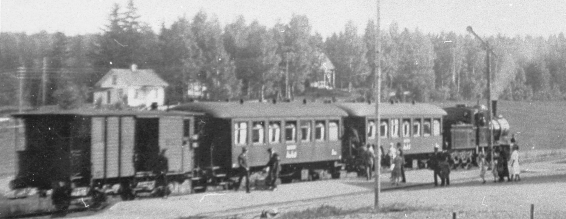|
Hem/Home
Fakta/Facts
Bana/Line
Fordon/Rolling
stock
Modell/Modelling
Forskning/Research
Länkar/Links
Kontakta/Contact
Updated: 17 Jan 2018
|
Lok/Engines
|
N:r
|
Litt
|
Wheel arrangement
|
Tillverkare/ Manufacturer
|
Tillverknings
nummer/ Manufacture's number
|
Tillverknings- år/ Year of manufacture
|
Ursprung/ Origins
|
Hyrt/ Leased
|
Inköpt/ Purchased
|
Sålt/Slopat Sold/Scraped
|
|
1
|
Kd
|
oCo
0-6-0
|
Nohab
|
415
|
1895
|
SJ 456
|
|
1927
|
1933-34
|
|
?
|
Kd1-Kc2
|
oCo
0-6-0
|
MV
|
109
|
1891
|
SJ 394
|
|
1927
|
1928-33
|
|
9
|
C
|
1BoT
2-4-0T
|
Nohab
|
191
|
1884
|
HNJ 9
|
|
1926
|
1933
|
|
14
|
L
|
1Co
2-6-0
|
Atlas
|
29
|
1895
|
HNJ Ea 14
|
1928
|
1930
|
DJ 14
1934, s/s 1940
|
|
15
|
L
|
1Co
2-6-0
|
Atlas
|
38
|
1900
|
HNJ Ea 15
|
1928
|
1930
|
DJ 15
1934, SJ L28 1865, s/s 1955
|
|
301
|
Kc5 Grisen
|
oCo
0-6-0
|
MV
|
103
|
1890
|
|
|
1926
|
1932
|
|
429
|
Kd
|
oCo
0-6-0
|
Nohab
|
357
|
1893
|
|
1928
|
|
1929
|
Nohab = Nydqvist och
Holm AB, MV = AB Motala Verkstad
ÅmÅJ was
unsuccessful in its purchase of engines, which lead to some of its later problems. The
railway had hoped to buy a type J engine from SJ, but SJ was unwilling
to sell any. Engines 9
and 301, which were originally purchased during the construction phase, were planned
to be used to for running
trains; however, the inspection authority (Väg- och Vättenbyggnadsstyrelse VoV) did
not pass the engines. Number
9 had been planned to make the run up to Kättilsbyn. Not having that engine
available lead to a
problem with how to get passengers the two kilometers there and back again to the mainline at Hallanda. Before
the purchase of the railbus,
a train would arrive in Hallanda, then, full of passengers, it would run up
to Kättilsbyn and back again
to then start on its journey again. Engines 14 and
15 were too large for the railway - they were too powerful
and used too much coal: however,
HNJ did not want to continue leasing the engines
and ÅmÅJ needed something, so they had to buy them.
ÅmÅJ bought several more appropriate engines, but was not able
to use them, but instead had
to use over dimensioned ones. Engine 9 was occasionally used on the mainline when the other engines were in for repair.
ÅmÅJ had inquired with SJ about the possibility of leasing an engine (a
type W) from them, but it was only around the time that ÅmÅJ filed for
bankruptcy that SJ had any engines free, due to electrification, for
lease.
Kanske lite
ironiska, men just vid ÅmÅJ:s konkurrens, SJ erbjöd ÅmÅJ möjligheten att
hyra ett W-lok. På grund av elektrifiering, behövde SJ inte så många lok.
Mera information över
loket finnas på sidan: Svenska-lok.se.
|
|
